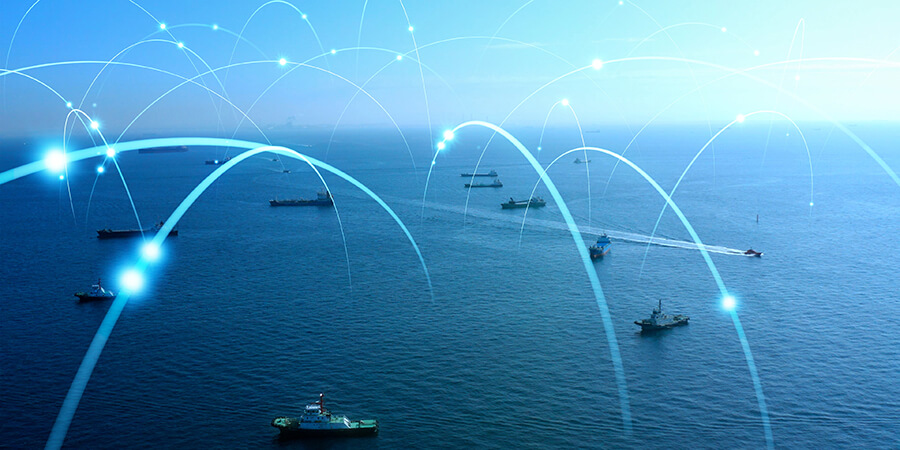Since the Titanic sank in 1912, the international maritime community has been committed to faster, more reliable and more efficient radiocommunication systems and services, both between ships and with stations on shore.
This tragic event highlighted the importance and necessity of efficient maritime communications as well as the need for standardized protocols and procedures for distress signals. It led to significant improvements in maritime safety regulations, including the establishment of 24-hour radio watch on vessels and the development of the International Convention for the Safety of Life at Sea (SOLAS) treaty, which mandated the provision of sufficient radio equipment on ships for distress communications.
Established in Geneva in 1948, the International Maritime Organization (IMO) sets global standards for radiocommunications in shipping through SOLAS, itself adopted in 1974. In particular, the Global Maritime Distress and Safety System (GMDSS) outlines the requirements for shipborne radio equipment and systems and ensures that a ship in distress at sea will always be heard and responded to, regardless of its location.
In addition to the distress and safety aspects, radiocommunications have also become an integral part of commercial shipping operations. Today, there is an intensified demand from the maritime industry for greater connectivity and higher data capacity to support all maritime operations.
What’s Coming in WRC-23
Maritime transport serves as the lifeblood of global trade, with approximately 80% of the world's merchandise being transported by sea. Over the years, radio communication has become a vital tool to declare a ship’s travel intentions, share its positions and avoid potential collisions.
In line with the International Telecommunication Union's (ITU) efforts, there is a great reliance on radio, radar, electronic systems and satellite navigation within the waters. These technologies not only facilitate operational communication but also enable seafarers to stay connected with their families and loved ones. In emergencies, radio distress signals are crucial in alerting search and rescue services.
The ITU has played a significant role in the development of terrestrial radio navigation systems that enhance safety at sea. This includes advancements in maritime radio beacons, terrestrial positioning systems operating in medium frequency (MF) bands, radar beacons and satellite positioning systems. These developments align with United Nations Sustainable Development Goal 9, which focuses on industry, innovation and infrastructure, including the enhancement of safety, security and comfort at sea.
As the World Radiocommunication Conference 2023 (WRC-23) approaches later this year in Dubai, expectations regarding the topic of maritime communications are high. Efforts are underway to improve existing systems and introduce new technologies to enhance safety, protect the maritime environment and optimize cargo transportation. The ITU-R studies, along with the resulting recommendations and reports, will provide valuable support for these endeavors.
“When ITU Member States update the Radio Regulations Treaty at WRC-23, they are expected to consider the modernization of the Global Maritime Distress and Safety System (GMDSS), the introduction of e-navigation systems, and other maritime communication issues. These changes should enable the industry to respond to emerging trends in maritime communications, including the transition to digital technologies and wireless applications,” says Mario Maniewicz, Director, ITU Radiocommunication Bureau.
GMDSS Modernization
The Global Maritime Distress and Safety System stands as a universally embraced framework encompassing a wide array of safety procedures, frequencies, equipment types and communication protocols. Developed through a collaboration between the IMO and ITU since the mid-1970s, it integrates terrestrial and satellite radio technologies on ships and onshore, facilitating the rescue of distressed individuals, ships, boats and aircraft. In situations of distress and emergency, the system notifies rescue and communication personnel at coast radio stations or Rescue Coordination Centers (RCC) and establishes contact with nearby vessels for assistance.
In light of a comprehensive evaluation of the GMDSS, the Maritime Safety Committee (MSC), during its 105th session, adopted several resolutions to finalize the modernization efforts and enable the future incorporation of advanced communication systems in the GMDSS while eliminating outdated requirements. These amendments are expected to come into effect on January 1, 2024.
While Inmarsat and Iridium have been recognized as GMDSS satellite operators, China's BeiDou has applied for recognition and could potentially become a third operator in the future, pending decisions during WRC-23.
Furthermore, there may be future modifications to providers of Maritime Safety Information (MSI), such as the possible replacement or complementation of Navigational Telex (NAVTEX) by Navigational Data (NAVDAT), a digital system operating in MF/HF maritime bands for the broadcast of safety and security information.
An emerging trend in maritime communications is the VHF Data Exchange System (VDES), developed by the International Association of Marine Aids to Navigation and Lighthouse Authorities (IALA). VDES aims to enable seamless data exchange within the maritime community and incorporates components such as the Automatic Identification System (AIS), Applications Specific Messages (ASM), VDE terrestrial component and VDE satellite component. The incorporation of the VHF Data Exchange System (VDES) into the broader e-navigation initiative holds tremendous potential for revolutionizing various aspects of maritime operations. By seamlessly integrating VDES into the e-navigation framework, we can unlock a multitude of applications that will not only bolster navigation safety but also elevate environmental conservation efforts, optimize shipping efficiency and transform maritime information services such as Aids to Navigation (AtN) and Vessel Traffic Service (VTS). This convergence of technologies promises to shape the future of maritime communication and pave the way for a more secure, sustainable and efficient maritime industry.
In a similar vein, automatic link establishment (ALE) technology has been developed to enable the automatic selection of frequencies for networked or point-to-point communication in the absence of operator intervention. This advancement, utilizing microprocessor control, encompasses features like automatic signaling, selective calling, automatic handshaking, channel scanning and selection, sounding, and message store-and-forward capabilities. These automated functions have particular relevance in the marine sector.
The future of the GMDSS Modernization Plan is intrinsically linked to the progress of the e-navigation project and the crucial role of radiocommunication in this endeavor. Undoubtedly, the establishment of a robust and resilient data communication network will be a fundamental aspect of the e-navigation implementation following WRC-23.
E-Navigation
Moving forward, in alignment with IMO’s strategic implementation plan on e-navigation, the next step is to introduce digital communication systems that support S-100 format files. A comprehensive analysis of e-navigation has revealed the necessity of presenting information in a graphical format, addressing the need for enhanced data visualization.
According to the IMO, e-navigation encompasses the harmonized collection, integration, exchange, presentation and analysis of marine information through electronic means. Its ultimate goal is to enhance berth-to-berth navigation, safety and security at sea, and environmental protection. To achieve this, e-navigation envisions the provision of digital information and infrastructure, enabling seamless communication links between ships and shore facilities. This entails utilizing high-speed broadband data connections to update computerized bridge displays with real-time information.
When it comes to e-navigation, there are specific expectations concerning the elements present onboard and ashore, as well as in terms of communications.
Onboard: The primary focus lies in navigation systems that capitalize on the integration of sensors within the ship, along with supporting data, a standardized user interface and a comprehensive system for managing guard zones and alerts. An essential component of such a system is actively involving mariners in the navigation process, empowering them to efficiently perform their duties while minimizing distractions and cognitive overload.
Ashore: The administration of vessel traffic and associated services undergoes a significant boost thanks to the enhanced provision, coordination and exchange of comprehensive data presented in user-friendly formats. These carefully designed formats guarantee that onshore operators can effortlessly grasp and leverage the information to fortify vessel safety and maximize operational efficiency.
Communications: The e-navigation infrastructure facilitates authorized and seamless information transfer onboard ships, between ships, between ship and shore, and among various shore authorities and other relevant parties. This robust communication network brings forth numerous benefits and opportunities for collaboration and coordination.
By embracing these principles, the maritime industry can navigate towards a future where digital communication systems, data integration and seamless information transfer revolutionize navigation, safety and operational efficiency at sea.











